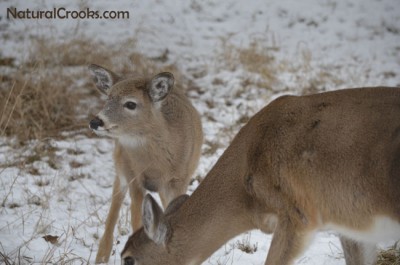Visiting a Winter Herd of White Tailed Deer in Mississauga, Ontario
My daughter’s friend told us of a great place to see White Tailed Deer in Mississauga, Ontario in winter. There’s a lubricants processing facility (which used to be a partial refinery) south of Orr Road off Southdown Road. Behind the security fence, which the deer can jump easily but people don’t usually climb, is a small herd of deer. The does and the offspring that were their fawns last year gather cheerfully by the fence. The bucks are more cautious but come over the small hill to visit some of the time and to keep an eye on the handouts.

The primary reason the deer collect here is the free food. People arrive daily with carrots and apples which they flip over the fence to coax the deer closer. The deer, though still cautious, will come right up to the fence edge occasionally. Mostly they prefer to stay a few feet back. If a noisy dog or an unusual vehicle arrives, they will sometimes bolt back up into the shrubs and over the hill, with their white flag tails raised.
Some of the shrubs lining the small hills in the area are sumac. The bark is off several feet up many of the lower trunks. I speculated aloud whether the deer had chewed off the bark. A gentleman nearby said actually most of the bark is lost to the bucks. When they are shedding their velvet from their antlers, they often rub against the sumac. (He lives in the area and sees the deer several times a day.)
While we were watching the deer and taking photos many cars pulled over to admire the herd before driving away.
Small groups of the deer approached the fence and moved away, along a section of about one quarter of a kilometre. They were coming forward to eat the food, mostly carrots, thrown over the fence for them. There were carrots still in the snow from earlier in the day.
Is Feeding Wild Deer Illegal, Immoral, Unethical or Otherwise a Bad Idea?
While watching the deer and taking photos, I wondered a bit about the practice of feeding them.
It’s not illegal here. (It is against local bylaws to feed Canada Geese in some areas.)
And the deer were in no danger of being lured into traffic. In fact, the deer seemed to prefer having the 8 foot fence between them and the people: they could easily have jumped out to where the people stood, but they chose not to. (The gentleman who lived in the area confirmed the deer do easily jump the fence from time to time to raid gardens and flower beds in the summer months.)
It’s not a picnic site or a hiking trail. So it seems unlikely that the deer will be trained to become aggressive towards people, approaching them to demand food. This can be a problem.
I remember long ago, when I was on top of Sulphur Mountain in the Rockies, a herd of about 10 female bighorn sheep approached my friend and I. We were eating our lunch while seated at a steep drop-off. The bighorns raced right towards us as if they might butt us off the cliff. (The females have small sharp horns like a goat’s.)
They didn’t charge us though. The sheep wanted to be fed. They came right up to us and stopped. We didn’t want to feed them. One licked at my hand which was funny but not too upsetting. But another started using its sharp hoof and muscular leg to paw at my legs which were guarding my knapsack which held my lunch. It actually hurt.
We had to get up and leave to get the bighorns to abandon us to look for an easier meal. I’ve always been aware since then that animals that are too tamed can be a potentially dangerous nuisance.
These white tailed deer, however, were not in an area where people normally walk, picnic or hike. So it seems less likely they will develop the habits those bighorns had.
There’s also some question in my mind about whether the food they are being offered is a good choice for them. In the wild, they do eat some apples. They mostly eat plants, though, and twigs and other scrub. It’s highly unlikely they would normally eat root vegetables like carrots more than once in a very long time.
All of the deer seemed in good condition with sleek coats, clear shiny eyes, and healthy looking noses. I know, however, that the outward appearance of the animals does not guarantee their inward health.
I never did decide whether feeding them is ok or not. There are certainly things to be said against it. But there’s also something to be said about the way people were reacting to the deer: the excitement, and pleasure and sense of connection. The young children were very pleased to see the deer, but the seniors and the parents were just as absorbed. People seem to crave a chance to see animals, wild or domestic, up close. This was giving them a reasonably safe way to enjoy the experience.
Join In
What do you think? Is feeding deer always a bad idea? Is there some redeeming merit to the practice? Would you feed one? Please share your experiences with a comment.


Deer will come up to you to eat out of your hand if you stand still.
I imagine they will if they are used to being fed by people.
Not getting into ethics but lots of fruit and vegetables contain high amounts of sugar which destroy their hooves. As with horses , same for deer: no hoof, no deer.
Interesting to know! Thanks for sharing!